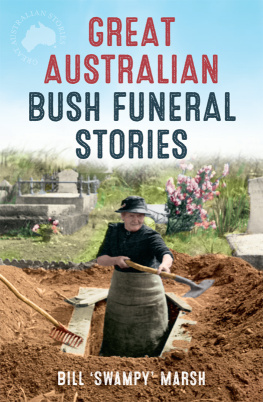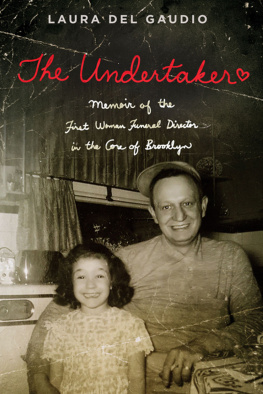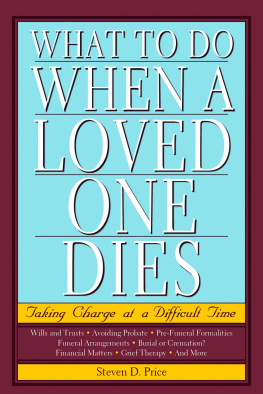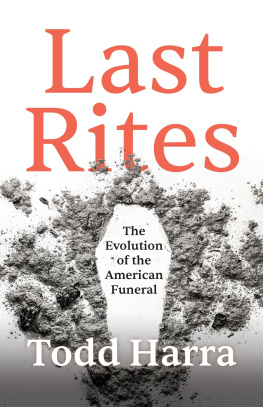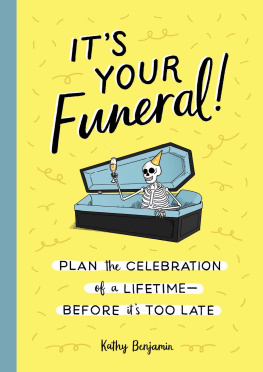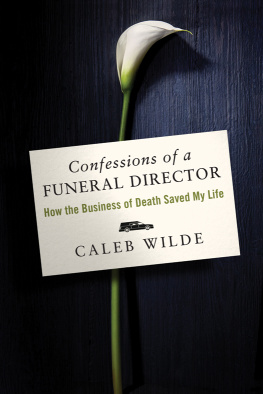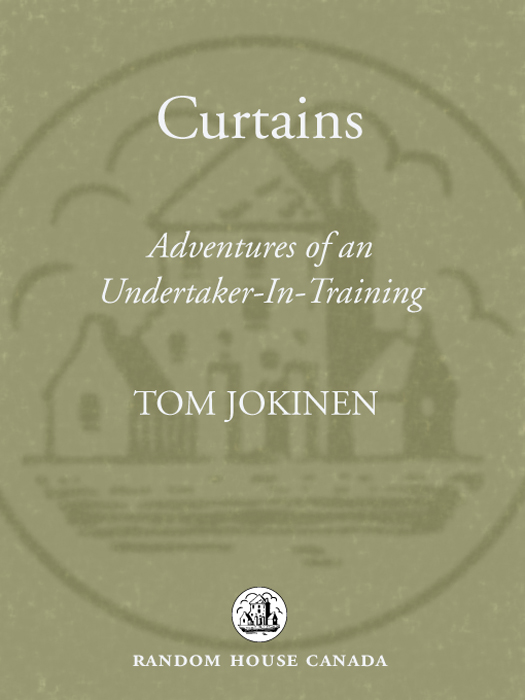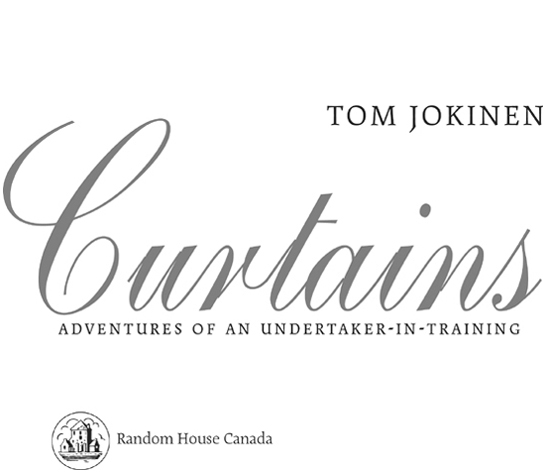Books are tombstones.
1.
2.
3.
4.
5.
6.
7.
8.
9.
10.
11.
12.
13.
14.
15.
16.
17.
18.
T wo rules for picking up a body at the hospital, known as a removal: (1) Make sure its the right one. This business, when you shake it down to first principles, is the burial or cremation of the dead, two relatively irreversible acts. Mistakes are frowned upon. Please check the ID tag carefully; and (2) Never stop for food on the way back to the funeral home when youre carrying, not even at a drive-thru. Its bad for the brand, and is apt to put other drive-thru-ers off their doughnuts.
Im anxious about my first removal at Seven Oaks Hospital, which has, Im told, a finicky loading dock that makes getting the stretcher into the van a game of brute strength and faith. And my stretcher technique is poor. I know this. Ive practised a few times with an empty stretcher, shuffling it in and out of the van at the crematorium. The stretcher has collapsing legs that fold under on the way in, and fall back into place on the way out. The trick is to make sure the legs snap back when you pull it out, to listen for the telltale click that says the legs are locked in place. Everyone talks about the click. If you dont hear the click, youll be picking your body up off the floor. In industry jargon, this is considered undignified, and dignity is an even bigger deal in funeral service than not going through the drive-thru with a dead body.
For the Seven Oaks gig, Glenn comes with me as a spotter. Glenn is younger than me; he runs his uncle Neils crematorium and in his off time he plays rugby and tends nighttime bar at the Pasta La Vista restaurant on Kenaston Boulevard. Hes not an undertaker: though Neil agreed to sponsor him at the embalming school, Glenn said he didnt want to spend his life stuffing cotton into orifices, thank you. But hes worked the technical side of funeral service since high school, during which time hes removed and cremated and buried scores of dead people, and sold pre-need funeral insurance to a few of the living.
At Seven Oaks, theres a hallway at the back near the loading dock, where the undertakers gather every day to pick up their cargo. Here they chat about the weather and hockey and chew nicotine gum while they wait for Security to unlock the Silver Doors like they are waiting for Walmart to open. Every hospital in Winnipeg has its Silver Doors, a gentle nickname for the morgue, only at Seven Oaks the entrance is neither silver nor plural: its just a door. It could be the entry to a janitors closet. Glenn makes small talk with a red-faced undertaker from another firm who wears a baseball jacket and tie, and tells us about the time he pulled the short straw and got the oversized body, a hernia case that took up two gurneys and nearly flipped off the stretcher on the way into the van. The mood is light, courteous. Me, Im rehearsing stretcher moves in my head. My track record with mechanical objects is spotty. Once, while trying to fix a bicycle chain, I got a knot in itwhich a mechanic told me was impossible until he saw it.
Security arrives, bored. We follow him into a small office. A wastebasket in the corner is full of latex gloves, and theres a baptismal font of Purell hand sanitizer on the wall. He checks our paperwork. Death is a bureaucratic event. No one is allowed to die unless the right forms are signed and cross-checked by a high-school dropout with a lot of keys. Then he opens another door, and I feel the cold breeze and smell what smells like a refrigerator that needs a box of baking soda. Its dark in this second, even smaller room, and I can make out a few gurneys set at odd angles. I expect big stainless steel drawers, but here, every cop procedural and scare-em-straight after-school special Ive ever watched has betrayed me. No drawers. The dead are on the gurneys, wrapped tight in white plastic from head to feet like frozen turkeys, packing tape around their necks and ankles. Four of them, identical. No toe tags even. Which one is ours?
Glenn and the red-faced undertaker commence shopping. Each body has a file card taped to its shin, an impression of its plastic hospital ID in purple ink.
Bingo.
Glenn has a match. Then, the other undertaker finds his. Glenn gives him a hand loading out and leaves me to check for valuables.
Here the job is to inspect the corpses hands for jewellery, rings and bracelets, and to double-check the hospital wristband while Im there. To do this I have to feel for the hands through the plastic and rip a hole in the shroud to get at them. I want to do this, to show Im able, but in fact Id rather cut off my own thumb with tin snips than hold hands with the dead.
Theyre folded on his belly. The plastic is thick, but I tear a gap. His hands are big, like he built things outdoors. Theyre yellow and cold, the nails white and trimmed too short. No rings, the wristband matches, and he has an IV lead taped to his wrist still red with dried blood. The moment seems to call for a gesture and all I can come up with is to give his hands a light squeeze. This is a lonely way to end up, wrapped in plastic in a room full of strangers, and if I think about it, and Id rather not, Ill end up in a cold room too, one day, maybe holding hands with a trainee undertaker who I hope will have better stretcher technique than me. Just not today, not next week, please, not for a while.
He slides on like a charm: shoulders and butt first, then the legs swing over. I brace the stretcher with my hip so it doesnt roll away. We strap him in with seat belts and cover him with the cloth sham, on which the name Neil Bardal Inc. is embroidered, since you never miss an opportunity to fly the company colours. Gloves come off, hands are ritually Purelld, and we head for the loading dock, leaving the last two wallflower corpses in the dark, still waiting for their rides. The dock turns out to be mismatched for the height of the van, but with Glenn ready to catch whatever falls, me or the stretcher, Im able to aim, trigger the collapsing legs when they hit the bumper and then let gravity do the rest. The body is now in the truck. I lock the stretcher in place with a cotter pin, so it doesnt roll out the back on the highway back to the crematorium like in a Flintstones episode, and were off.
Glenn once removed a body at a seniors complex in Winnipeg. It was Halloween. When he got there the corpse was still in the bed where it died. He strapped the body to the stretcher, and on the way out, the doors of the elevator opened onto a costume party, staff and residents dressed like Disney characters. What could he do? He had to slalom his stretcher through the wheelchairs, those in the crowd alternately wondering who was under the cloth and whether they would be next. A nurse dressed as Snow White scowled. Glenn might as well have been carrying a scythe. This, he says, is why the Silver Doors are always in the back of the hospital with the laundry bags and medical waste. People dont want to know. Theres a time, from when someone dies to when they magically pop up at the funeral or the cemetery or as a bag of ashes, that remains a black hole, invisible to the rest of the world, and everyones happy with the arrangement. We in funeral service cover the gap. People pay us to keep to ourselves what goes on there.



